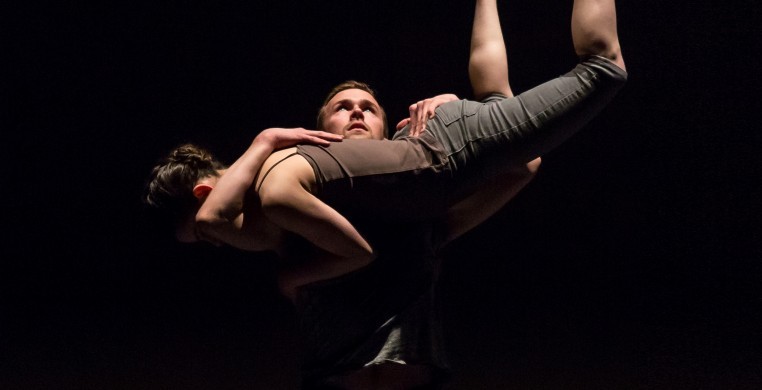If you were looking through a choreographic lens at the program of five works on Visceral Dance Chicago’s one-night-only 3rd season at the Harris Theater Saturday night, you might think, ah, this is all about shining a spotlight on the poignance and power of gesture.
Or, seen through another lens, you might say it was all about the wonderful dancers in this bright new troupe, whose title is an adjective that means “profound, intense; relating to the internal organs.” Intense they are, and they certainly dance from the heart. Whether or not you find their work profound, the dancing is beautiful.
Company artistic director Nick Pupillo, along with fellow dance makers Ohad Naharin, Fernando Melo, and Brian Enos, offered up a pleasing palette that covered all bases: lyricism, humor, pathos, and spot-on dancing pyrotechnics.
Pupillo’s “Sum Noir” (2015) opened to an eerie tableau of all ten dancers slowly rocking side to side in silence. A stark black stage, grey fog, and costume designer Maggie Dianovsky’s shades-of-black smoking jackets and slacks, halter tops and shirred ankle-length skirts were effective in creating an other-world dreamscape. The repetition of rocking, which recurs throughout the piece as a motif, dares to prolong itself almost to the brink of discomfort before gradual acceleration bursts into lush group movement. A collage of striking imagery--two men leaning on each other for leverage, a rush of reconfiguring group patterns, and plenty of flouncy lifts and leaps--is interrupted by intermittent stillness, keenly focused on the slightest nuance of gesture: a hand to the cheek or across the eyes, where every single move counts. There is an abundance of ideas here. Pupillo is clearly in love with movement, and is undeniably driven to seek the outer limits of the human body to sing out with a full, unrestrained voice. In this piece, it’s a voice that has so much to say, and so intense a need to say it, that much of it comes out all at once in a perpetual avalanche of movement vocabulary that does not yet color its words, sentences, and paragraphs with enough structural purpose or particularly distinctive design to make it notable. The occasional return to stillness is the saving grace of “Sum Noir,” where the quiet exploration of a simple gesture illuminates the beauty of the dance.
A single, heart-stopping gesture is at the center of Ohad Naharin’s “Duet Mabul” (1992), in the company’s repertory for the past two years. A gorgeous duet of passion in a layered and complex male-female relationship, it opens with the man, Karl Watson, his spine completely bent over his knees, head lowered beneath outstretch arms, his clasped hands oscillating in a pleading supplication toward the woman, Caitlin Cucchiara, as they cross the stage. Set to music by Vivaldi, “Duet Mabul” paints a picture of intimacy that exposes the raw core of both pain and ecstasy, danced here to breathtaking perfection.
The company premiere of Fernando Melo’s theatrical “Bate” (2005) offered a completely different, humorous take on the nature of male-female relations. Beginning with a partial view of the action beneath a minimally raised curtain, Melo effectively heightens audience awareness of the power of gesture by framing dramatic events in windows of varying size that appear and disappear at intervals across the back of the stage. Isolated body parts reveal a disembodied female arm, male head, legs, or torso in some aspect of boy gets girl gets boy. By teasing the audience with delicious puzzle pieces of what must be a much bigger picture, we join in a delightful game, filling in what’s missing. An especially hilarious segment is structured almost like a baroque fugue, beginning with a movement study of one male dancer, his body like a balloon inflating and deflating to the exaggerated sound effects of inhaling and exhaling. The humor is heightened as he is joined by another and yet another, until all five men are on the same yo-yo journey on the road to romance. As tantalizing as the first three-quarters of this piece is, the culminating quintet, in the only sequence that uses the full view of an open stage, fell short of expectations for a climactic finish, set up by the earlier segments.
Pupillos’ sensual “She Three” (world premiere) begins with three women on their bellies in individual pin-point spotlights. Each of the three--Cucchiara, Paige Fraser, and Noelle Kayser--unfolds in turn with a movement portrait tailor-made to her individual strengths and unique qualities. Pupillo brings the three together to interact in partnering that achieves stunning sculptural dimensions. Sweeping arms, liquid spines that melt into cascading back arches, sky-high extensions, and rippling body undulations characterize this abstract composite of womanhood.
Brian Enos‘ mystical “Hadal Zone” (2015) closed the evening with a somewhat spooky take on conformity and isolation.The full company fairly glowed in Dianovsky’s irridescent green togs, from a slow, deliberate first movement to the fast driving exchanges and precision unison work of the second. Partnering featured lightning-fast lifts into unexpected shapes. The Visceral crew was more than up to the technically challenging demands of the choreography, which underscored the impressive caliber this company has achieved so early in its development. A simple theme of the individual up against conformity of the masses isn’t new but provided a suitable architecture upon which to hang high stakes dancing. A preponderance of athletic running and the use of blinding lights shined into the audience bordered on the clichéd, but in the end, overall dance excitement won the day.

